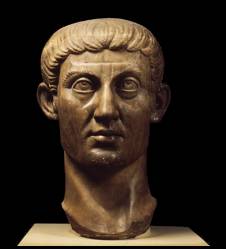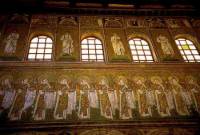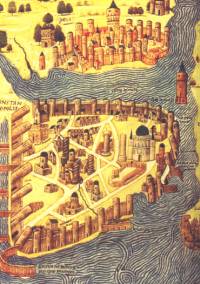
 |

THE FORGOTTEN EMPIRE
Why everyone, not just mosaicists, should know about Byzantium. Last year I undertook a mini poll. I asked twenty citizens of Bradford, in the north of England, what they knew about the Byzantine Empire. Their collective response - 'Nowt', and its synonyms. One girl did say, 'Gold... Icons...', and a young man, 'I see Russia. I see a crown. A crown with jewels hanging from it. Right, luv?' But no-one could name any building, any emperor, or any event in its history. Nowt, near enough. And yet they were all children of Byzantium. We all are, in Britain, in Europe, in the West. We have all sheltered within the walls of Constantinople. And we don't know it - it's a safe bet that 95% of all Britons know as little as my Bradford sample. I didn't know owt about Byzantium until I was in my forties, and only discovered it because of Wagner. Yes, Richard. To know him is to know his amazing patron, King Ludwig II of Bavaria; and after years of wondering why Ludwig built a Byzantine throne room in Neuschwanstein Castle (the Disneyland one) and planned bedrooms and palaces in the same style, I finally borrowed a book about a Byzantine empress called Theodora, and promptly fell in love. Not with her, though she was clearly a corker - with her Empire, her world. It was a revelation; scales tumbled from my eyes. Ich bin ein Byzantiner.
Like most people, I'd been brought up to think that our Western civilisation started with the Greeks, continued with the Romans, enter Christianity, then came The Fall Of The Roman Empire (476 A.D.), the Dark Ages, the Middle Ages, and so on. What no-one told us was that the Roman Empire did NOT fall in 476. The Western half of the Empire fell to the barbarians, certainly. Goths, Vikings, all that. But the Eastern half, centered on Constantine's New Rome (alias Byzantium, Constantinople, Czargrad, Micklegarth and Istanbul), carried on for another thousand years - all in all it lasted for much longer than the original Roman Empire did. And for half that time, until the Middle Ages really got going, the Byzantine Empire was Christian civilisation. And it was superb. And to the end they called themselves Romans. Why weren't we told? We are the heirs of Athens not least because Byzantium preserved Classical Greek literature for us. Byzantium gave us Roman law and State organisation. While civilisation in Dark Age Western Europe was - in Lord Clark's phrase - 'squeaking through by the skin of its teeth', the perfumed courtiers of Constantinople quoted Homer much as we quote Shakespeare, and State bakers debated the drawbacks of Monophysitism. Central heating, polo, orphanages, baths, planning regulations, toilets, trade guilds, gold automata, hospitals, weights and measures legislation, women doctors, hydraulic air conditioning - Constantinople had all these.
For centuries this marvellous Christian city withstood ferocious attacks by Goths, Huns, Slavs and Persians. Charlemagne's grandfather stopped the Arabs at Poitiers, true, but if Constantinople had not been a bulwark against the other arm of the Arab advance, it's my guess that Bradford would have had its first mosque in 973, not 1973. We all know about people and stories from Roman history - Hannibal and the Battle of Cannae, Anthony and Cleopatra, Nero and the Christians, etc. etc. - but Byzantium has people and stories just as good. Try Justinian and the Victory riots, Heraclius and the Return of the True Cross, Zoe the Empress who brewed perfumes in her bedroom, Basil the Bulgar-Butcher, or the murderous sex-glutton emperor Andronicus and his horrific end... Byzantine art and architecture was glorious. Exquisite ivories, silk embroideries, illuminated manuscripts. Gold reliquaries studded with jewels and enamels. Churches and palaces adorned with multi-coloured marbles, their vaults and domes glittering with gold mosaics. At Daphni, the huge mosaic of Christ the Almighty is the most awe-inspiring image of God the Son ever created. In Constantinople the Harrowing of Hell fresco in the Chora church is as great as anything in the Sistine chapel. The mighty church of St. Sophia, built by the emperor Justinian, is greater than St. Peter's. I'm in love, remember.
Byzantine art, especially the superb mosaics, influenced painters like Giotto and El Greco. And when Charlemagne built his palace at Aachen, the chapel there derived from one at New Rome's vast Imperial Palace, that wonder of the world, now alas no more. Another vanished Byzantine wonder, the Church of the Apostles, was the model for St. Mark's, Venice. Those four bronze horses used to preside over chariot races at the Hippodrome in Constantinople. They are in Venice because in 1204 the Roman Catholic Franks, Germans and Venetians of Pope Innocent III's Fourth Crusade, driven by need, greed and envy, turned aside and sacked Constantinople. It was the first time the city had fallen, and was one of the great cultural crimes of history, something that the Orthodox Christians of Byzantium have never forgotten. It made certain that the separation between Catholic and Orthodox would remain an unhealed wound. We should have been told.
Though the Byzantines got the Crusaders out after sixty years, that attack fatally weakened the Empire, and the Turks slowly but surely closed in. The West would not help. When Constantinople fell for the second and last time, in 1453, the last emperor, Constantine XI, died fighting alongside his troops, as an emperor should. His body was never found; just the red Imperial buskins, or so the legend goes. It's a great story. A thought. On the night before the Turks made their final assault on the city, Orthodox and Roman Catholic Christians alike gathered in Justinian's Great Church of St. Sophia and, all differences laid aside, celebrated the holy liturgy together. It took the Fall of Constantinople to do it, but they got there. They could do it again... Meanwhile, how about making the history of the Byzantine Empire part of the National Curriculum?
Paul Bentley
|
All
content is copyright of © Mosaic Matters and its contributors.
All rights reserved
Mosaic
Matters is:
Editor: Paul Bentley
Web Manager/Designer: Andy Mitchell




